MARKET OVERVIEW
The Global Diabetic Retinopathy market and its industry hold a significant position within the healthcare landscape, addressing one of the most pressing complications associated with diabetes. Diabetic retinopathy, a condition resulting from damage to the blood vessels in the retina due to high blood sugar levels, remains a leading cause of blindness among adults. This market encompasses a wide range of diagnostic, therapeutic, and surgical solutions aimed at managing and treating this eye condition.
Advancements in medical technology have significantly influenced the Global Diabetic Retinopathy market. With the rise in the prevalence of diabetes worldwide, there is a heightened demand for effective diagnostic tools and treatment options. Companies are investing heavily in research and development to innovate new products and improve existing ones. Cutting-edge diagnostic techniques, such as optical coherence tomography (OCT) and fluorescein angiography, are becoming more sophisticated, providing detailed imaging that aids in early detection and monitoring of diabetic retinopathy.
The market is also witnessing significant growth in the therapeutics sector. Intravitreal injections of anti-VEGF (vascular endothelial growth factor) agents have revolutionized the treatment paradigm for diabetic retinopathy, offering patients improved outcomes and reduced risks of vision loss. Additionally, laser therapy and vitrectomy are established treatment modalities that continue to evolve with technological advancements, enhancing their efficacy and safety profiles.
Geographically, the Global Diabetic Retinopathy market spans North America, Europe, Asia-Pacific, Latin America, and the Middle East & Africa. Each region presents unique opportunities and challenges. North America and Europe, with their advanced healthcare infrastructures and high awareness levels, are at the forefront of market development. In contrast, the Asia-Pacific region is emerging as a lucrative market due to the increasing diabetic population and improving healthcare access. Governments and healthcare organizations in these regions are also undertaking various initiatives to raise awareness about diabetic retinopathy and promote early diagnosis and treatment.
The competitive landscape of the Global Diabetic Retinopathy market is marked by the presence of several key players who are actively engaged in strategic collaborations, mergers, and acquisitions to strengthen their market positions. These companies are also focusing on expanding their product portfolios and geographical reach to cater to the growing demand.
The market will likely experience further expansion driven by continuous advancements in medical technologies, increasing prevalence of diabetes, and growing awareness about diabetic retinopathy. Moreover, the integration of artificial intelligence and machine learning in diagnostic tools is anticipated to enhance the accuracy and efficiency of screening processes, thereby improving patient outcomes.
The regulatory environment plays a crucial role in shaping the Global Diabetic Retinopathy market. Stringent regulations and approval processes for new drugs and medical devices ensure the safety and efficacy of treatments available to patients. Regulatory agencies in different regions are also working towards harmonizing standards to facilitate smoother market entry for innovative products.
The Global Diabetic Retinopathy market stands as a vital segment of the healthcare industry, addressing a significant and growing public health issue. With ongoing advancements in medical technology, increasing global awareness, and proactive regulatory frameworks, this market is poised for sustained growth and innovation. Efforts to improve early diagnosis, enhance treatment options, and ensure patient access to quality care will continue to drive the evolution of the diabetic retinopathy market in the coming years.
Global Diabetic Retinopathy market is estimated to reach $26,392.0 Million by 2031; growing at a CAGR of 9.1% from 2024 to 2031.
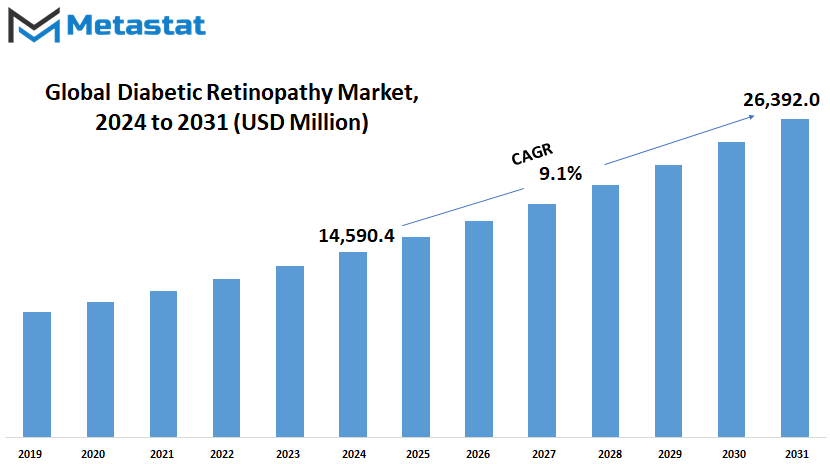
GROWTH FACTORS
The global market for diabetic retinopathy is poised for significant growth, driven by several key factors. As diabetes continues to rise worldwide, particularly in developing nations, the incidence of diabetic retinopathy also increases. This, in turn, fuels the demand for diagnostic and treatment solutions. The growing prevalence of diabetes necessitates comprehensive eye care services to manage and mitigate the effects of diabetic retinopathy, a condition that can lead to severe vision impairment if left untreated.
Technological advancements in ophthalmic imaging and screening techniques are enhancing the early detection and management of diabetic retinopathy. Innovations such as advanced retinal imaging systems and non-invasive screening methods are making it easier to identify the condition at earlier stages. This early detection is crucial in preventing the progression of diabetic retinopathy and improving patient outcomes, thereby driving market growth.
Despite these advancements, there are challenges that hinder the market's expansion. Limited access to eye care services and screening programs, especially in rural and underserved areas, significantly impacts early diagnosis and treatment. In many regions, the availability of specialized ophthalmic care is sparse, and patients often face long travel distances to receive necessary care. This lack of accessibility delays diagnosis and treatment, exacerbating the condition.
Moreover, the high costs associated with diagnostic tests and treatment modalities for diabetic retinopathy pose affordability issues. In several areas, the expense of advanced diagnostic equipment and specialized treatments limits their uptake, restricting market growth. Patients in low-income regions often struggle to afford these services, leading to delayed or forgone treatment.
However, the future of the diabetic retinopathy market holds promising opportunities. The integration of artificial intelligence (AI) and telemedicine platforms into screening programs offers scalable and cost-effective solutions for remote diagnosis and management. AI can enhance the accuracy of screenings and facilitate the analysis of large volumes of retinal images, making early detection more efficient. Telemedicine allows for the provision of eye care services in remote and underserved areas, improving accessibility and reach.
These advancements in AI and telemedicine are expected to expand the market's reach and accessibility, providing lucrative opportunities for growth in the coming years. By addressing the challenges of limited access and high costs, these technologies can revolutionize the way diabetic retinopathy is diagnosed and managed, ensuring more patients receive timely and effective care.
While the global diabetic retinopathy market faces challenges related to accessibility and affordability, the rising prevalence of diabetes and technological advancements in ophthalmic care are driving its growth. The integration of AI and telemedicine holds the potential to overcome these obstacles, offering a brighter future for the early detection and management of diabetic retinopathy.
MARKET SEGMENTATION
By Type
Diabetic retinopathy is a serious eye condition affecting many individuals with diabetes, leading to vision impairment and potentially blindness if untreated. With the growing prevalence of diabetes worldwide, the global market for diabetic retinopathy treatments is set to expand significantly in the future. This market can be segmented by type into Proliferative Diabetic Retinopathy (PDR) and Diabetic Macular Edema (DME), both of which present unique challenges and opportunities for treatment and management.
Proliferative Diabetic Retinopathy is an advanced stage of diabetic retinopathy where abnormal blood vessels grow on the surface of the retina. These vessels can leak or bleed, causing severe vision problems. On the other hand, Diabetic Macular Edema involves swelling in the macula, the part of the retina responsible for sharp central vision, due to fluid accumulation. Both conditions require timely and effective treatment to prevent significant vision loss.
The future of the diabetic retinopathy market looks promising due to advancements in medical technology and increased awareness of diabetes-related complications. Innovations such as improved diagnostic tools, more effective drugs, and advanced surgical techniques are expected to drive market growth. For instance, the development of anti-VEGF (vascular endothelial growth factor) therapies has revolutionized the treatment of DME, providing better outcomes for patients.
Additionally, the integration of artificial intelligence (AI) in diagnostic procedures is another area poised for significant growth. AI can enhance early detection and monitoring of diabetic retinopathy by analyzing retinal images with high accuracy, thus facilitating timely intervention. This technological progress not only improves patient care but also reduces healthcare costs by preventing severe complications through early treatment.
Furthermore, as healthcare infrastructure improves globally, especially in developing regions, access to diabetic retinopathy treatments will increase. This will likely lead to a larger market for these therapies, as more individuals will seek and receive proper eye care. Education campaigns aimed at both healthcare providers and patients about the importance of regular eye exams for diabetics will also contribute to early diagnosis and treatment.
By Treatment Type
The future of the global diabetic retinopathy market looks promising, with significant advancements expected across various treatment types. Diabetic retinopathy, a common complication of diabetes that affects the eyes, is becoming a growing concern as the number of diabetic patients increases worldwide. As we look ahead, the market is set to expand, driven by innovations and improvements in treatment options.
One of the primary treatment types for diabetic retinopathy is Anti-VEGF (vascular endothelial growth factor) drugs. These medications work by inhibiting the growth of abnormal blood vessels in the retina, a hallmark of the disease. As research progresses, we anticipate the development of more effective and longer-lasting Anti-VEGF drugs. These advancements will not only improve patient outcomes but also reduce the frequency of treatments, making management of the condition more convenient for patients.
Steroid implants are another important treatment option. These implants release corticosteroids into the eye, helping to reduce inflammation and swelling, thereby preventing further damage to the retina. Future developments in this area may focus on creating implants with more precise delivery systems and fewer side effects. This could make steroid implants a more attractive option for patients and healthcare providers alike.
Laser surgeries have long been a standard treatment for diabetic retinopathy. These procedures use focused light beams to treat or prevent abnormal blood vessel growth in the retina. Looking ahead, advancements in laser technology are likely to enhance the precision and effectiveness of these surgeries. We can expect new laser systems that minimize damage to surrounding tissues and offer faster recovery times, thus improving the overall patient experience.
Vitrectomy, a surgical procedure that involves removing the vitreous gel from the eye, is often used in more severe cases of diabetic retinopathy. As surgical techniques and equipment continue to advance, vitrectomies are expected to become safer and more efficient. Innovations such as smaller surgical instruments and better imaging technologies will likely lead to improved outcomes and quicker recovery periods for patients undergoing this procedure.
Overall, the global diabetic retinopathy market is poised for substantial growth. As treatment options continue to evolve, they will offer better efficacy, reduced side effects, and greater convenience for patients. These advancements will not only improve the quality of life for those affected by diabetic retinopathy but also alleviate the burden on healthcare systems worldwide. With continued research and innovation, the future of diabetic retinopathy treatment holds great promise, paving the way for a healthier and brighter future for patients around the globe.
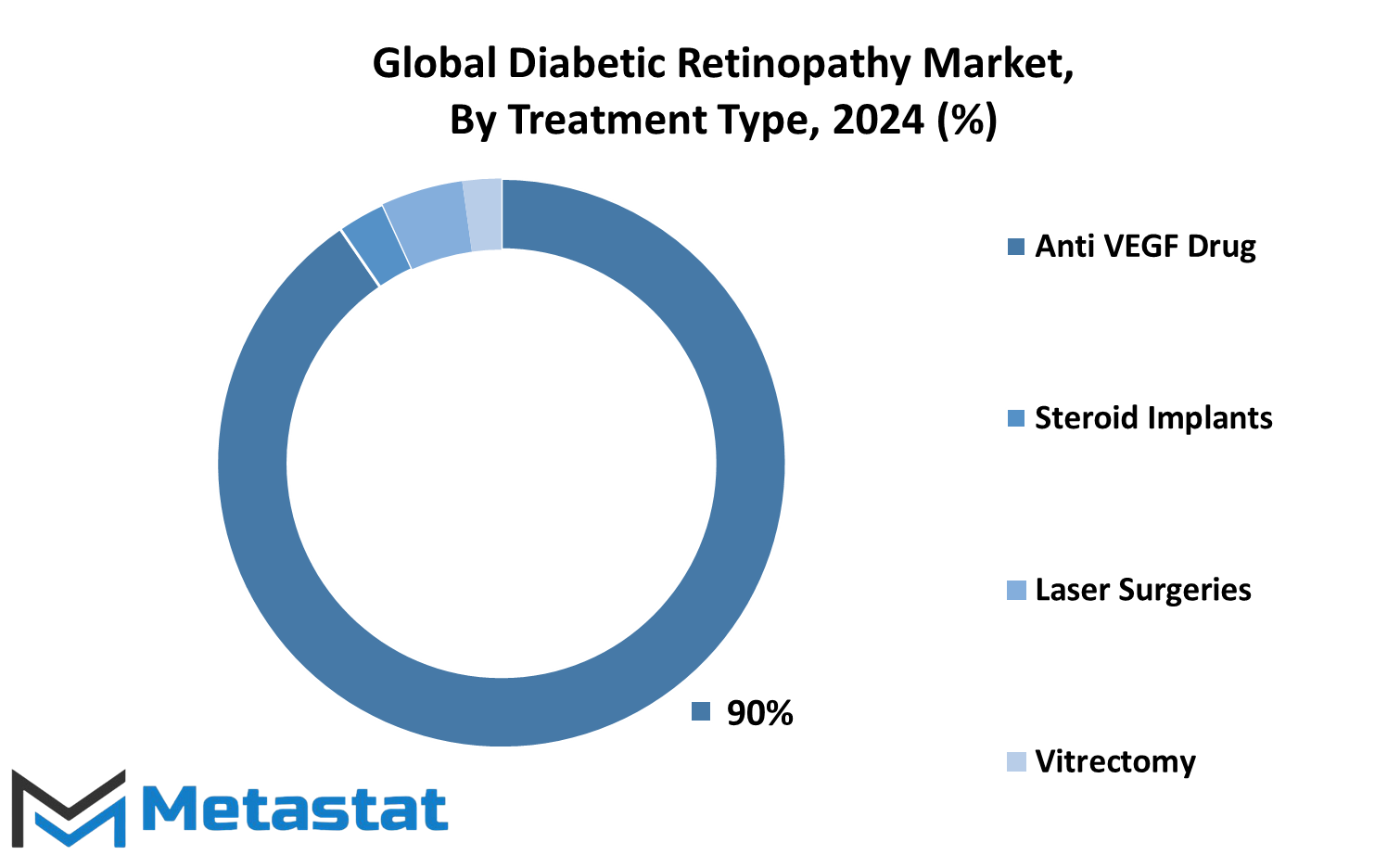
REGIONAL ANALYSIS
The global market for diabetic retinopathy is witnessing significant changes across various regions, and this trend is expected to continue in the future. As we look ahead, it is essential to understand how different parts of the world are contributing to this evolving landscape.
In North America, the market is primarily driven by the United States, Canada, and Mexico. The U.S. leads the way due to its advanced healthcare infrastructure and a high prevalence of diabetes. Canada follows with its strong focus on healthcare research and development. Mexico, though still developing its healthcare capabilities, is increasingly recognizing the importance of addressing diabetic retinopathy, given its rising diabetes rates.
Europe also plays a crucial role in the diabetic retinopathy market. The United Kingdom, Germany, France, and Italy are key players due to their robust healthcare systems and significant investments in medical research. These countries are continually advancing their diagnostic and treatment methods, aiming to improve patient outcomes. Other European nations contribute to the market, though on a smaller scale, collectively enhancing the region's market presence.
Asia-Pacific is a region of immense potential and rapid growth. India and China are at the forefront, driven by their large diabetic populations and improving healthcare access. Japan and South Korea are notable for their technological advancements and high-quality healthcare services, contributing significantly to market development. Other countries in the region are also gradually enhancing their healthcare frameworks to better manage diabetic retinopathy, recognizing its growing importance as a public health issue.
South America, particularly Brazil and Argentina, is beginning to make strides in the diabetic retinopathy market. Brazil, with its expanding healthcare sector, is focusing on better diagnosis and treatment options. Argentina, though smaller, is also making progress in addressing diabetic-related eye conditions. Other countries in the region are slowly but steadily improving their healthcare systems to tackle this issue more effectively.
The Middle East and Africa present a unique scenario. The Gulf Cooperation Council (GCC) countries, including Saudi Arabia, the United Arab Emirates, and others, are investing heavily in healthcare infrastructure, driven by their high diabetes rates. Egypt and South Africa are also notable contributors, with efforts to improve healthcare accessibility and quality. The rest of the region is working on developing better healthcare systems, recognizing the critical need to address diabetic retinopathy.
The global diabetic retinopathy market is characterized by regional diversity and varying degrees of development. As healthcare systems worldwide continue to evolve, there is a collective movement towards better managing and treating this condition. Each region, with its unique strengths and challenges, contributes to the dynamic and growing global market for diabetic retinopathy, aiming for a future where this condition is more effectively controlled and treated.
COMPETITIVE PLAYERS
The future of the Diabetic Retinopathy market is poised for significant growth as key players in the industry continue to develop innovative treatments and technologies. Diabetic Retinopathy, a complication of diabetes that affects the eyes, is a major concern worldwide. As the prevalence of diabetes increases, the demand for effective treatments for Diabetic Retinopathy is also rising. The competitive landscape of this market is shaped by several leading companies that are at the forefront of research and development.
Alimera Science, Inc. is a notable player, focusing on therapies that address the unmet needs of patients with retinal diseases. Their emphasis on delivering sustained-release treatments could revolutionize how Diabetic Retinopathy is managed. Abbvie, Inc., with its robust pipeline of pharmaceuticals, is also making strides in this area, leveraging its expertise to bring new solutions to the market.
Ampio Pharmaceuticals, Inc. is exploring novel approaches to treat inflammation and improve outcomes for patients with Diabetic Retinopathy. Bayer AG continues to be a strong contender, utilizing its extensive research capabilities to develop cutting-edge treatments. Kowa Co., Ltd. is known for its commitment to ophthalmology and its efforts to provide comprehensive eye care solutions.
Novartis, a global healthcare leader, is making significant investments in ophthalmology, including treatments for Diabetic Retinopathy. Pfizer, Inc., with its vast resources and innovative research, is another key player contributing to advancements in this field. Regeneron Pharmaceuticals, Inc. is recognized for its development of effective therapies for retinal diseases, setting new standards in patient care.
F-Hoffmann-La Roche Ltd. is actively involved in the development of targeted therapies that aim to address the underlying causes of Diabetic Retinopathy. Samsung Bioepis, in collaboration with Biogen, is working on biosimilar treatments that could provide more accessible options for patients. Clearside Biomedical is focusing on innovative drug delivery methods to enhance the efficacy of treatments for retinal conditions.
Ellex and IRIDEX Corporation are also making significant contributions with their advanced laser technologies designed to treat Diabetic Retinopathy. Glenmark Pharmaceuticals Limited, AstraZeneca, and Johnson Eyecare & Eyewear are investing in research to develop new and effective treatments. Eli Lilly and Company continues to leverage its expertise in diabetes care to improve outcomes for patients with Diabetic Retinopathy.
The competitive landscape of the Diabetic Retinopathy market is dynamic, with each player bringing unique strengths and innovations to the table. As these companies continue to advance their research and develop new therapies, the future of Diabetic Retinopathy treatment looks promising. With ongoing collaboration and innovation, the goal of improving the quality of life for millions of people affected by this condition is becoming increasingly attainable.
Diabetic Retinopathy Market Key Segments:
By Type
- Proliferative Diabetic Retinopathy
- Diabetic Macular Edema (DME)
By Treatment Type
- Anti VEGF Drug
- Steroid Implants
- Laser Surgeries
- Vitrectomy
Key Global Diabetic Retinopathy Industry Players
- Alimera Science, Inc.
- Abbvie, Inc.
- Ampio Pharmaceuticals, Inc.
- Bayer AG
- Kowa Co., Ltd.
- Novartis
- Pfizer, Inc.
- Regeneron Pharmaceuticals, Inc.
- F-Hoffmann-La Roche Ltd.
- Samsung Bioepis/Biogen
- Clearside Biomedical
- Ellex
- IRIDEX Corporation
- Glenmark Pharmaceuticals Limited
- Astrazeneca
WHAT REPORT PROVIDES
- Full in-depth analysis of the parent Industry
- Important changes in market and its dynamics
- Segmentation details of the market
- Former, on-going, and projected market analysis in terms of volume and value
- Assessment of niche industry developments
- Market share analysis
- Key strategies of major players
- Emerging segments and regional growth potential



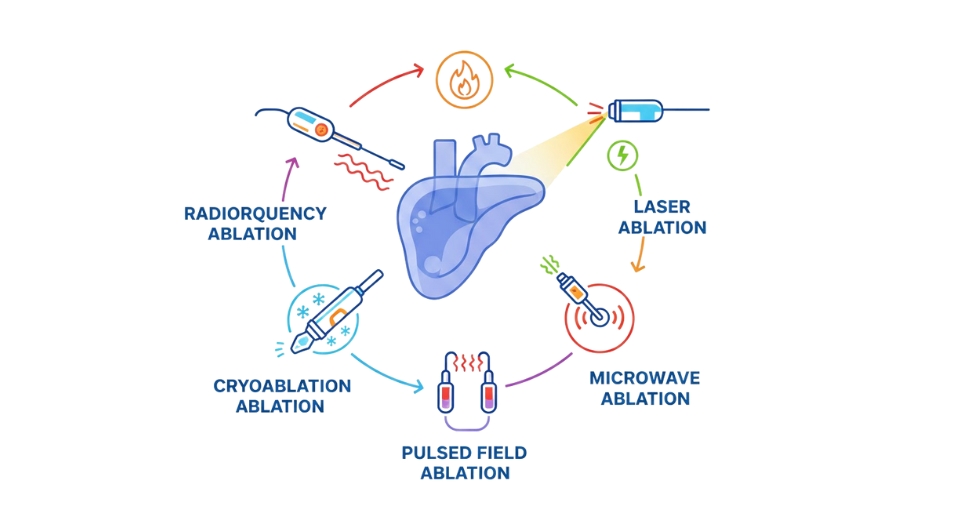

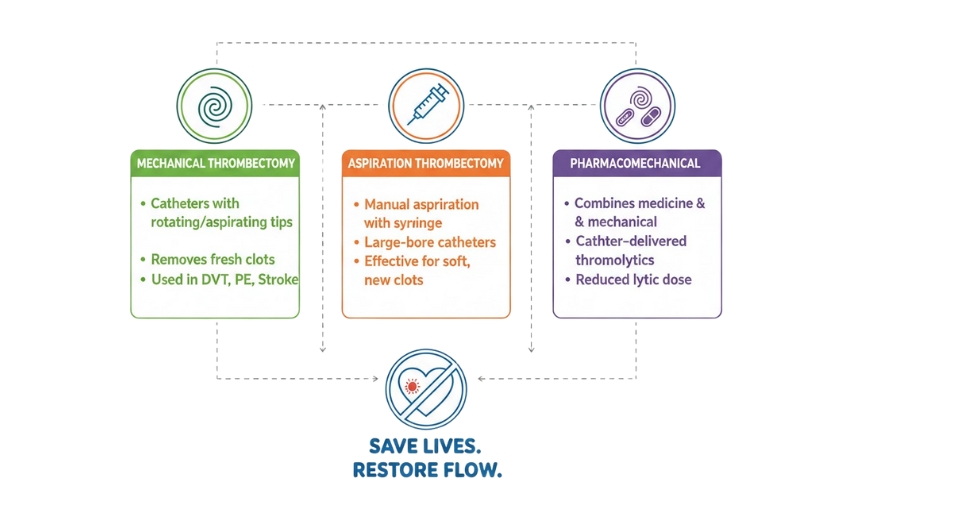
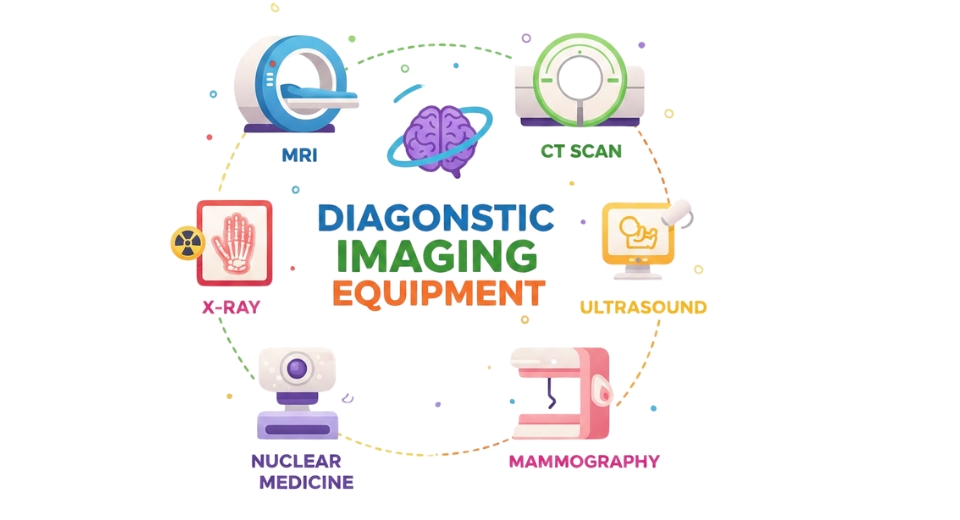

 US: +1 3023308252
US: +1 3023308252






